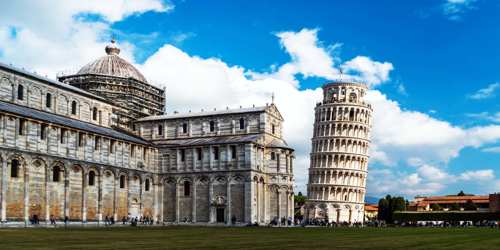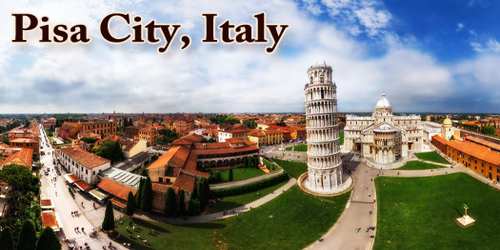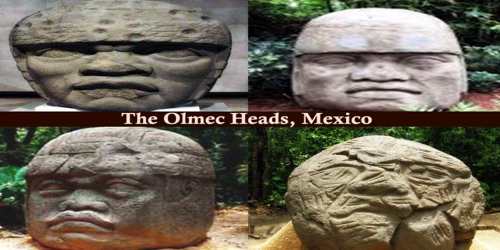Pisa (/ˈpiːzə/ PEE-zə, Italian: [ˈpiːza] or [ˈpiːsa]), city, central Italy, in the Toscana (Tuscany) regione. The city lies on the alluvial plain of the Arno River, about 6 miles (10 km) from the Ligurian Sea and 50 miles (80 km) west of Florence. Pisa lay by the sea until the 15th century, by which time accumulated silt deposited by the Arno River had completely cut the city off from the receding shoreline.
It is the capital city of the Province of Pisa. Although Pisa is known worldwide for its leaning tower (the bell tower of the city’s cathedral), the city of over 91,104 residents (around 200,000 with the metropolitan area) contains more than 20 other historic churches, several medieval palaces, and various bridges across the Arno. Much of the city’s architecture was financed from its history as one of the Italian maritime republics.
The city is also home of the University of Pisa, which has a history going back to the 12th century and also has the Scuola Normale Superiore di Pisa, founded by Napoleon in 1810, and its offshoot, the Sant’Anna School of Advanced Studies, as the best-sanctioned Superior Graduate Schools in Italy.

Pisa, Italy is best known for its leaning tower, but there is so much more to see in this Tuscan town. Piazza dei Miracoli, the area around the cathedral and the tower, is beautiful, and a visit can easily occupy several hours. Pisa was one of the four great maritime republics in the Middle Ages, and it retains a good selection of monuments from that era. There’s also the Arno River, a university, and several interesting museums. It’s a good city for strolling and enjoying at a leisurely pace.
The old town encompasses Renaissance architecture and churches: The Campo dei Miracoli complex, declared a UNESCO World Heritage Site, is the most representative structure of the city. The Piazza del Duomo, renowned for being Galileo’s scientific laboratory, is the ideal starting point to retrace the footsteps of this revolutionary Italian scientist through the city. The central Piazza dei Cavalieri (Knights’ Square) is a magnificent sight, home to intricate 16th-Century architecture such as the Palazzo della Carovana, the house of the distinguished Scuola Normale Superiore, commissioned by Napoleon Bonaparte to be based on the model of the École Normale Supérieure in Paris. Many of the most celebrated Italian professors studied here, like Antonio Pacinotti (Astronomy), Giosuè Carducci and Giovanni Pascoli (Literature), and Ernico Fermi and Carlo Rubbia (Physics).
Ancient Pisa, or Pisae, was possibly inhabited by the Ligurians before passing under Roman control as a naval base. It became a Roman colony shortly after 180 BCE and by 313 CE had become a Christian bishopric. Pisa survived the collapse of the Roman Empire to remain the principal urban centre of Tuscany. Exploiting its sea power and the products and markets of its fertile Tuscan hinterland, the city revived in the 11th century to become a flourishing commercial centre. With the help of Genoa, it also took the initiative against Muslim raiders.
In 1016 the Pisans and Genoese drove the Saracens from Sardinia, and in 1063 the Pisan fleet sacked Muslim Palermo. The city’s participation in the Crusades secured valuable commercial positions for Pisan traders in Syria, and thereafter Pisa grew in strength to rival Genoa and Venice.
In the 12th century, Pisa obtained the rule of favorite nation in place of Venice.
From the middle of the 12th century, Pisa expanded towards the inland of Tuscany: in the south towards Piombino and towards lower Veldarno.
The economic power of the Republic caused the antagonism with the rival cities such as Genoa, Venice and Amalfi. The last one was supported by Pope Innocenzo II, who was in conflict with the anti-pope Anacleto, who was supported by Ruggero II of Sicily.
The city that had German emperors, showed devotion for the pope, with a Ghibelline tendence, that was in contrast with the Guelph faction of Florence and Lucca. During this period there were important political changes. Pisa’s mercantile classes, who were extremely powerful, obtained the elimination of the consul charge and the insurgence of a new figure: “Il capitano del Popolo” (the Captain of People). After the rivalry between Della Gherardesca and Visconti families, in which attended the Emperor Federico II in order to find reconciliation, people ordered through a riot the institution of the 12 Anziani. In this way there were both the legislative advises of the nobles and the popular ones. This last group was composed by delegates of the main arts and those ones who belonged to the popular comapanies that ratify laws.
In the 13th century, Pisa, a Ghibelline city, enjoyed the support of the German emperors in its long conflicts with Genoa at sea and with its Tuscan rivals, Lucca and Florence, on land. These struggles culminated in Pisa’s defeat by the Genoese fleet at the decisive Battle of Meloria in 1284. This defeat ended the maritime power of Pisa and the town never fully recovered; in 1290, the Genoese destroyed forever the Porto Pisano (Pisa’s port), and covered the land with salt. The region around Pisa did not permit the city to recover from the loss of thousands of sailors from the Meloria, while Liguria guaranteed enough sailors to Genoa. Goods, however, continued to be traded, albeit in reduced quantity, but the end came when the Arno started to change course, preventing the galleys from reaching the city’s port up the river. The nearby area also likely became infested with malaria. The true end came in 1324, when Sardinia was entirely lost in favour of the Aragonese.
Internal factional struggles helped to bring about the occupation of Pisa by the Florentines in 1406. Large quantities of merchandise continued to pass through the city until the 15th century, when silting made the movement of laden galleys up the Arno River almost impossible. When French armies invaded Italy in 1494, Pisa temporarily reasserted its independence; the city sustained a series of wars and sieges until Florence reconquered it in 1509. Thereafter it declined as a provincial Tuscan town. Pisa grew again after the mid-18th century as the surrounding marshlands were reclaimed, malaria was eliminated, and light industries were developed. In World War II Pisa suffered severe damage in 1944 when prolonged fighting took place on the Germans’ Gothic Line (Pesaro-Rimini) of defenses. The many churches damaged or ruined at this time were subsequently restored, but the area south of the river, which suffered widespread destruction, still has a somewhat characterless aspect.
The renaissance of Pisa began in the 16th century, thanks to Cosimo I of Medici who was used to spend here long periods, further from Florence. Especially the Duke did lots of drainages of fields, enacted economical and legal facilitations in order to repopulate the city. What is more, the Duke changes the appereance of Pisa: along the banks of Arno, he built noble residences instead of the landing place such as Palazzo Reale, the wonderful Church of Santo Stefano dei Cavalieri and the Cavalieri Square.

Pisa’s development continued under the power of Francesco I and Ferdinando I. The last one ordered the construction of Canale of Navicelli and Logge of Bianchi. During the 16th century happened many disasters such as plague, the fire of the Cathedral and the collapse of the bridge which was joining the two banks of the river: Pontevecchio. Florence was the centre of the power while the port used by Medici was that one of Livorno.
The city of Pisa is surrounded by little towns, like San Miniato and Volterra, overlooking the picturesque Valle dell’Arno. San Gimigniano, the suggestive wine territory of Chianti, and the beautiful Tuscan countryside and beaches are nearby. From Pisa, it is easy to travel to cities like Florence, Lucca, and Siena to spend the day admiring the richness of Italian art and culture. Pisa international airport, “Galileo Galilei,” connects the city to the major European capitals. The train is a convenient way to reach Italian cities like Bologna (1.45 hrs.), Rome (2.30 hrs.) and Venice (3.15 hrs.).
Pisa is now a quiet provincial university town that is renowned for its art and architectural treasures. The city also retains much of its 6.5-mile (10.5-kilometre) circuit of walls. Pisa is distinguished above all by a remarkable group of buildings in the Piazza del Duomo, the so-called Square of Miracles, located at the northwestern end of the medieval walled city. This piazza contains the cathedral, or Duomo; the baptistery; the campanile, or Leaning Tower of Pisa; and the camposanto, or cemetery.
The city can be hot and crowded in the summer, especially in the area around the cathedral and tower. Many tourists come only for the day, so if people were visiting in high season, they might want to spend the night and enjoy the sites in the morning or evening. Spring and fall are the most pleasant times to visit Pisa.
Pisa experiences a borderline humid subtropical (Cfa) and Mediterranean climate (Köppen climate classification Csa), since only a single month receives less than 40 mm (1.6 in) of rain. The city is characterized by cool-mild winters and hot summers. This transitional climate keeps Pisa from enjoying a summer devoid of rain, typical of central and southern Italy, as the summer (the driest season) experiences occasional rain showers. Rainfall peaks in the autumn.
Both the cathedral and the baptistery are built of white marble with strips of black in the Pisan Romanesque style, which features colonnades and the decorative use of pointed arches. The cathedral, begun in 1063, has a nave with double-vaulted aisles and transepts with single-vaulted ones, and a cupola at the intersection of the two axes. On the western front, the range of arches running around the base of the cathedral is repeated in four open arcades. A marvelous bronze door (c. 1180) by Bonanno Pisano, which depicts biblical scenes, survives on the southern side. Inside the cathedral is a splendid decagonal pulpit carved in white marble (1302-11; restored 1926) by Giovanni Pisano.
In the Second World War, the city of Pisa suffered strong fascist repressions. On August 31st, 1943, Pisa was bombed by U.S.A aviation and many districts were razed to the ground. Other bombings provoked the loss of inique works of art and finally Pisa reached the Liberation.
Pisa’s notable old churches, lying mostly north of the river, include San Pierino (11th-12th century); San Frediano and San Sepolcro (both 12th century); San Nicola, with a four-storied tower of about 1250; San Francesco (13th century), which has frescoes painted by Taddeo Gaddi in 1342; Santa Caterina (13-14th century); San Michele in Borgo, with a fine 14th-century facade; and Santa Maria della Spina, which is built of white marble in the Pisan Gothic style and was enlarged in 1323. The city’s secular buildings include several fine medieval and Renaissance palazzi.
Pisa was the birthplace of the scientist Galileo Galilei. The University of Pisa, founded in 1343, had more than 25,000 students in the late 20th century. The city remains the seat of an archbishopric. Pisa is now an important railway junction and has an international airport. Tourism and light industries that produce textiles, glass, and engineering and pharmaceutical goods contribute to the economy. Pop. (2011) 85,858.
The Gioco del Ponte or “bridge game” is a re-enactment of a medieval contest between Pisans living north of the Arno River and those living south of the river. A parade with participants dressed in medieval costume begins the festival, then two teams of 20 people push a huge cart along the middle of the bridge, trying to reach the opposite team’s area.
Information Sources:
















